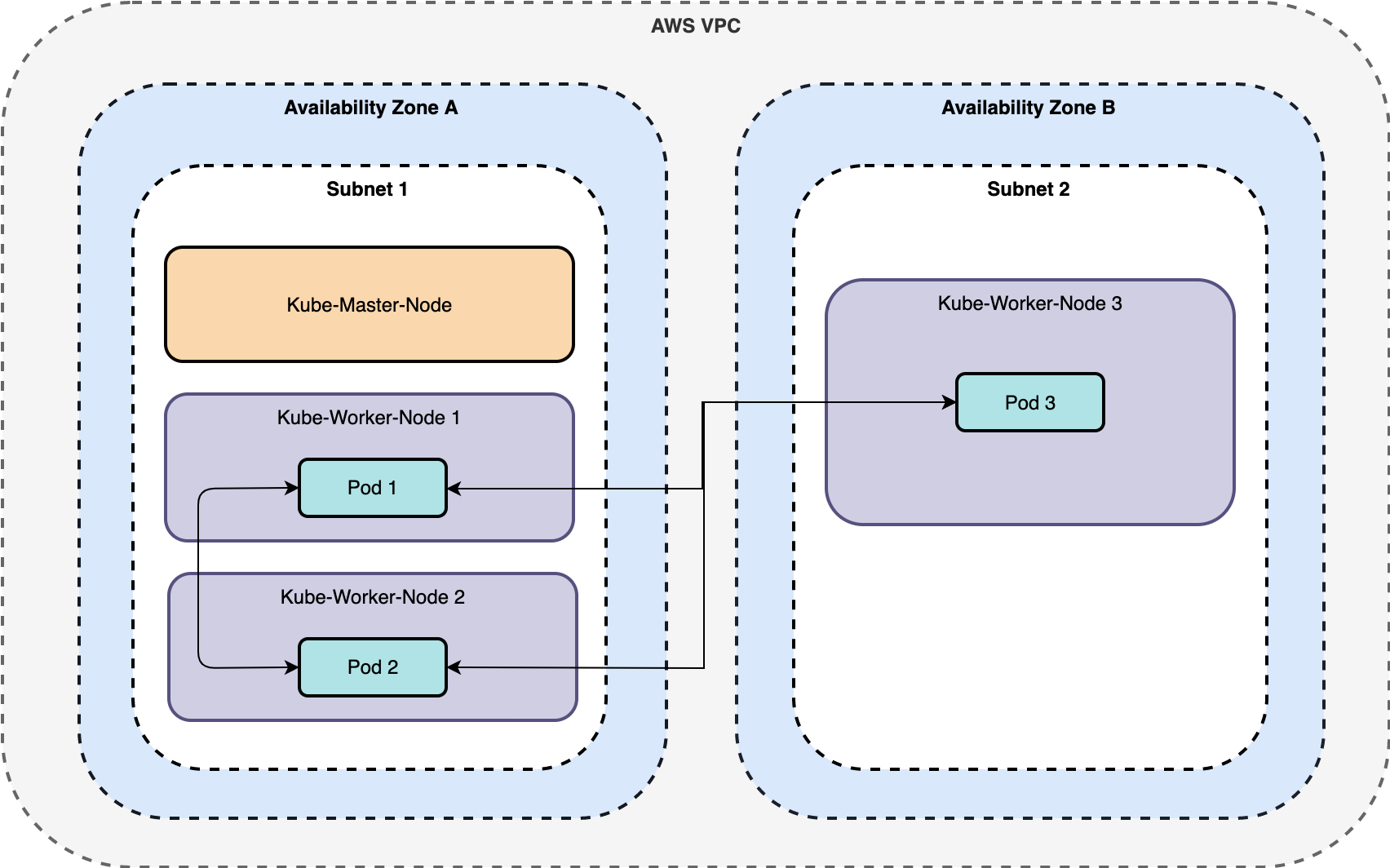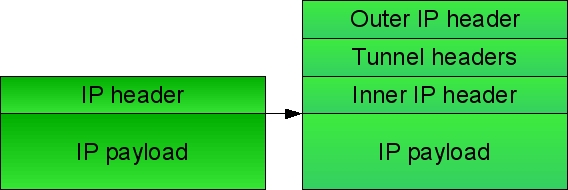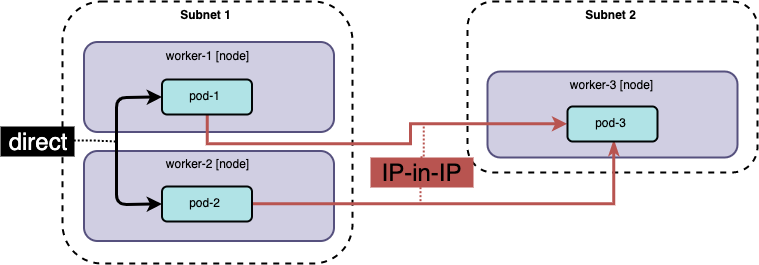Calico Routing Modes
How does Calico route container traffic? Many say "It uses BGP to route unencapsulated traffic providing near-native network performance." They aren’t completely wrong. It is possible to run Calico in this mode, but it is not the default. It’s also a common misconception that BGP is how Calico routes traffic; it is part, but Calico may also leverage IP-in-IP or VXLAN to perform routing. In this post, I’ll attempt to explain the routing options of Calico and how BGP compliments each.
Click here to watch the video version of this content.Example Architecture
For this demonstration, I have setup the following architecture in AWS. The terraform is here. The Calico deployment is here.

For simplicity, there is only 1 master node. Worker nodes are spread across availability zones in 2 different subnets. There will be 2 worker nodes in subnet 1 and 1 worker node in subnet 2. Calico is the container networking plugin across all nodes. Throughout this post, I'll refer to these nodes as follows.
master: Kube-Master-Node, subnet 1worker-1: Kube-Worker-Node 1, subnet 1worker-2: Kube-Worker-Node 2, subnet 1worker-3: Kube-Worker-Node 3, subnet 2
These are consistent with the node names in my Kubernetes cluster.
NAME STATUS ROLES AGE VERSION
master Ready master 6m55s v1.17.0
worker-1 Ready <none> 113s v1.17.0
worker-2 Ready <none> 77s v1.17.0
worker-3 Ready <none> 51s v1.17.0
Pods are deployed with manifests for pod-1, pod-2, and pod-3.
NAME READY STATUS RESTARTS AGE NODE
pod-1 1/1 Running 0 4m52s worker-1
pod-2 1/1 Running 0 3m36 worker-2
pod-3 1/1 Running 0 3m23s worker-3
Route Sharing
By default, Calico uses BGP to distribute routes amongst hosts. Calico-node pods run on every host. Each calico-node peers together.

The calico-node container hosts 2 processes.
-
BIRD: Shares routes via BGP.
-
Felix: Programs host route tables.
BIRD can be configured for advanced BGP architectures, such as centralized route sharing via route reflectors and peering with BGP-capable routers. Using calicoctl, you can view nodes sharing routes.
$ sudo calicoctl node status
Calico process is running.
IPv4 BGP status
+--------------+-------------------+-------+----------+-------------+
| PEER ADDRESS | PEER TYPE | STATE | SINCE | INFO |
+--------------+-------------------+-------+----------+-------------+
| 10.30.0.206 | node-to-node mesh | up | 18:42:27 | Established |
| 10.30.0.56 | node-to-node mesh | up | 18:42:27 | Established |
| 10.30.1.66 | node-to-node mesh | up | 18:42:27 | Established |
+--------------+-------------------+-------+----------+-------------+
IPv6 BGP status
No IPv6 peers found.
Each host IP represents a node this host is peering with. This was run on
master and the IPs map as:
10.30.0.206: worker-110.30.0.56: worker-210.30.1.66: worker-3
Once routes are shared, Felix programs a host's route table as follows.
# run on master
$ route -n
Kernel IP routing table
Destination Gateway Genmask Flags Metric Ref Use Iface
0.0.0.0 10.30.0.1 0.0.0.0 UG 100 0 0 ens5
10.30.0.0 0.0.0.0 255.255.255.0 U 0 0 0 ens5
10.30.0.1 0.0.0.0 255.255.255.255 UH 100 0 0 ens5
172.17.0.0 0.0.0.0 255.255.0.0 U 0 0 0 docker0
192.168.97.192 10.30.1.66 255.255.255.192 UG 0 0 0 tunl0
192.168.133.192 10.30.0.56 255.255.255.192 UG 0 0 0 tunl0
192.168.219.64 0.0.0.0 255.255.255.192 U 0 0 0 *
192.168.219.65 0.0.0.0 255.255.255.255 UH 0 0 0 cali50e69859f2f
192.168.219.66 0.0.0.0 255.255.255.255 UH 0 0 0 calif52892c3dce
192.168.226.64 10.30.0.206 255.255.255.192 UG 0 0 0 tunl0
These routes are programmed for IP-in-IP traffic. Each host's pod CIDR
(Destination + Genmask) goes through a tunl0 interface. Pods, with endpoints,
have a cali* interface, which is used for network policy enforcement.
Routing
Calico supports 3 routing modes.
-
IP-in-IP: default; encapsulated
-
Direct: unencapsulated
-
VXLAN: encapsulated; no BGP
IP-in-IP and VXLAN encapsulate packets. Encapsulated packets “feel” native to the network they run atop. For Kubernetes, this enables running a 'virtual' pod network independent of the host network.
IP-in-IP
IP-in-IP is a simple form of encapsulation achieved by putting an IP packet inside another. A transmitted packet contains an outer header with host source and destination IPs and an inner header with pod source and destination IPs.

In IP-in-IP mode, worker-1's route table is as follows.
# run on worker-1
sudo route

Below is a packet sent from pod-1 to pod-2.
# sent from inside pod-1
curl 192.168.133.194

IP-in-IP also features a selective mode. It is used when only routing between subnets requires encapsulation. I’ll explore this in the next section.
I believe IP-in-IP is Calico’s default as it often just works. For example, networks that reject packets without a host's IP as the destination or packets where routers between subnets rely on the destination IP for a host.
Direct
Direct is a made up word I’m using for non-encapsulated routing. Direct sends packets as if they came directly from the pod. Since there is no encapsulation and de-capsulation overhead, direct is highly performant.
To route directly, the Calico IPPool must not have IP-in-IP enabled.
To modify the pool, download the default ippool.
calicoctl get ippool default-ipv4-ippool -o yaml > ippool.yaml
Disable IP-in-IP by setting it to Never.
apiVersion: projectcalico.org/v3
kind: IPPool
metadata:
# remove creationTimestamp, resourceVersion,
# and uid if present
name: default-ipv4-ippool
spec:
blockSize: 26
cidr: 192.168.0.0/16
ipipMode: Never
natOutgoing: true
nodeSelector: all()
vxlanMode: Never
Apply the change.
calicoctl apply -f ippool.yaml
On worker-1, the route table is updated.
route -n

2 important changes are:
- The
tunl0interface is removed and all routes point toens5. worker-3's route points to the network gateway (10.30.0.1) rather than the host.- This is because worker-3 is on a different subnet.
With direct routing, requests from pod-1 to pod-2 fail.
# sent from pod-1
$ curl -v4 192.168.133.194 --max-time 10
* Trying 192.168.133.194:80...
* TCP_NODELAY set
* Connection timed out after 10001 milliseconds
* Closing connection 0
curl: (28) Connection timed out after 10001 milliseconds
Packets are blocked because src/dst checks are enabled. To fix this, disable these checks on every host in AWS.

Traffic is now routable between pod-1 and pod-2. The wireshark output is as
follows.
curl -v4 192.168.133.194

However, communication between pod-1 and pod-3 now fails.
# sent from pod-1
$ curl 192.168.97.193 --max-time 10
curl: (28) Connection timed out after 10000 milliseconds
Do you remember the updated route table? On worker-1, traffic sent to
worker-3 routes to the network gateway rather than to worker-3. This is
because worker-3 lives on a different subnet. When the packet reaches the
network gateway, it does not have a routable IP address, instead it only sees
the pod-3 IP.
Calico supports a CrossSubnet setting for IP-in-IP routing. This setting tells
Calico to only use IP-in-IP when crossing a subnet boundary. This gives you
high-performance direct routing inside a subnet and still enables you to route
across subnets, at the cost of some encapsulation.

To enable this, update the IPPool as follows.
apiVersion: projectcalico.org/v3
kind: IPPool
metadata:
name: default-ipv4-ippool
spec:
blockSize: 26
cidr: 192.168.0.0/16
ipipMode: CrossSubnet
natOutgoing: true
nodeSelector: all()
vxlanMode: Never
calicoctl apply -f ippool.yaml
Now routing between all pods works! Examining worker-1's route table:

The tunl0 interface is reintroduced for routing to worker-3.
VXLAN
VXLAN routing is supported in Calico 3.7+. Historically, to route traffic using VXLAN and use Calico policy enforcement, you’d need to deploy Flannel and Calico. This was referred to as Canal. Whether you use VXLAN or IP-in-IP is determined by your network architecture. VXLAN is feature rich way to create a virtualized layer 2 network. It fosters larger header sizes and likely requires more processing power to facilitate. VXLAN is great for networks that do not support IP-in-IP, such as Azure, or don’t support BGP, which is disabled in VXLAN mode.
Setting up Calico to use VXLAN fundamentally changes how routing occurs. Thus rather than altering the IPPool, I'll be redeploying on a new cluster.
To enable VXLAN, as of Calico 3.11, you need to make the following 3 changes to the Calico manifest.
- Set the
backendtovxlan.
kind: ConfigMap
apiVersion: v1
metadata:
name: calico-config
namespace: kube-system
data:
# Typha is disabled.
typha_service_name: “none”
# value changed from bird to vxlan
calico_backend: “vxlan”
- Set the
CALICO_IPV4_IPIPpool toCALICO_IPV4_VXLAN.
# Enable VXLAN
- name: CALICO_IPV4POOL_VXLAN
value: "Always"
- Disable BGP-related liveness and readiness checks.
livenessProbe:
exec:
command:
- /bin/calico-node
- -felix-live
# disable bird liveness test
# - -bird-live
periodSeconds: 10
initialDelaySeconds: 10
failureThreshold: 6
readinessProbe:
exec:
command:
- /bin/calico-node
- -felix-ready
# disable bird readiness test
# - -bird-ready
periodSeconds: 10
Then apply the modified configuration.
kubectl apply -f calico.yaml
With VXLAN enabled, you can now see changes to the route tables.

Inspecting the packets shows the VXLAN-style encapsulation and how it differs from IP-in-IP.

Summary
Now that we've explored routing in Calico using IP-in-IP, Direct, and VXLAN, I hope you’re feeling more knowledgable about Calico’s routing options. Additionally, I hope these options demonstrate that Calico is a fantastic container networking plugin, extremely capable in most network environments.